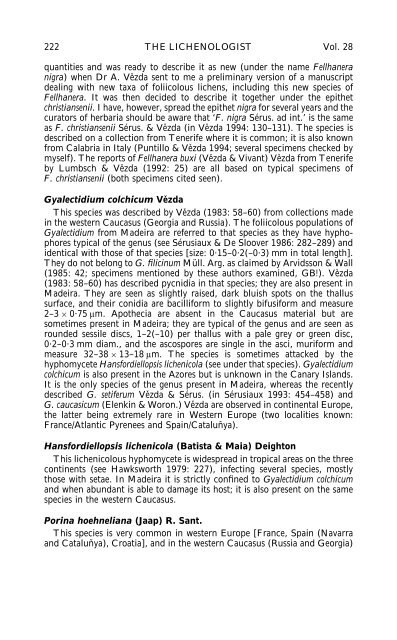Foliicolous lichens from Madeira, with the description of a new ...
Foliicolous lichens from Madeira, with the description of a new ...
Foliicolous lichens from Madeira, with the description of a new ...
Create successful ePaper yourself
Turn your PDF publications into a flip-book with our unique Google optimized e-Paper software.
222 THE LICHENOLOGIST Vol. 28<br />
quantities and was ready to describe it as <strong>new</strong> (under <strong>the</strong> name Fellhanera<br />
nigra) when Dr A. Vězda sent to me a preliminary version <strong>of</strong> a manuscript<br />
dealing <strong>with</strong> <strong>new</strong> taxa <strong>of</strong> foliicolous <strong>lichens</strong>, including this <strong>new</strong> species <strong>of</strong><br />
Fellhanera. It was <strong>the</strong>n decided to describe it toge<strong>the</strong>r under <strong>the</strong> epi<strong>the</strong>t<br />
christiansenii. I have, however, spread <strong>the</strong> epi<strong>the</strong>t nigra for several years and <strong>the</strong><br />
curators <strong>of</strong> herbaria should be aware that ‘F. nigra Sérus. ad int.’ is <strong>the</strong> same<br />
as F. christiansenii Sérus. & Vězda (in Vězda 1994: 130–131). The species is<br />
described on a collection <strong>from</strong> Tenerife where it is common; it is also known<br />
<strong>from</strong> Calabria in Italy (Puntillo & Vězda 1994; several specimens checked by<br />
myself). The reports <strong>of</strong> Fellhanera buxi (Vězda & Vivant) Vězda <strong>from</strong> Tenerife<br />
by Lumbsch & Vězda (1992: 25) are all based on typical specimens <strong>of</strong><br />
F. christiansenii (both specimens cited seen).<br />
Gyalectidium colchicum Vězda<br />
This species was described by Vězda (1983: 58–60) <strong>from</strong> collections made<br />
in <strong>the</strong> western Caucasus (Georgia and Russia). The foliicolous populations <strong>of</strong><br />
Gyalectidium <strong>from</strong> <strong>Madeira</strong> are referred to that species as <strong>the</strong>y have hyphophores<br />
typical <strong>of</strong> <strong>the</strong> genus (see Sérusiaux & De Sloover 1986: 282–289) and<br />
identical <strong>with</strong> those <strong>of</strong> that species [size: 0·15–0·2(–0·3) mm in total length].<br />
They do not belong to G. filicinum Müll. Arg. as claimed by Arvidsson & Wall<br />
(1985: 42; specimens mentioned by <strong>the</strong>se authors examined, GB!). Vězda<br />
(1983: 58–60) has described pycnidia in that species; <strong>the</strong>y are also present in<br />
<strong>Madeira</strong>. They are seen as slightly raised, dark bluish spots on <strong>the</strong> thallus<br />
surface, and <strong>the</strong>ir conidia are bacilliform to slightly bifusiform and measure<br />
2–30·75 μm. Apo<strong>the</strong>cia are absent in <strong>the</strong> Caucasus material but are<br />
sometimes present in <strong>Madeira</strong>; <strong>the</strong>y are typical <strong>of</strong> <strong>the</strong> genus and are seen as<br />
rounded sessile discs, 1–2(–10) per thallus <strong>with</strong> a pale grey or green disc,<br />
0·2–0·3 mm diam., and <strong>the</strong> ascospores are single in <strong>the</strong> asci, muriform and<br />
measure 32–3813–18 μm. The species is sometimes attacked by <strong>the</strong><br />
hyphomycete Hansfordiellopsis lichenicola (see under that species). Gyalectidium<br />
colchicum is also present in <strong>the</strong> Azores but is unknown in <strong>the</strong> Canary Islands.<br />
It is <strong>the</strong> only species <strong>of</strong> <strong>the</strong> genus present in <strong>Madeira</strong>, whereas <strong>the</strong> recently<br />
described G. setiferum Vězda & Sérus. (in Sérusiaux 1993: 454–458) and<br />
G. caucasicum (Elenkin & Woron.) Vězda are observed in continental Europe,<br />
<strong>the</strong> latter being extremely rare in Western Europe (two localities known:<br />
France/Atlantic Pyrenees and Spain/Cataluñya).<br />
Hansfordiellopsis lichenicola (Batista & Maia) Deighton<br />
This lichenicolous hyphomycete is widespread in tropical areas on <strong>the</strong> three<br />
continents (see Hawksworth 1979: 227), infecting several species, mostly<br />
those <strong>with</strong> setae. In <strong>Madeira</strong> it is strictly confined to Gyalectidium colchicum<br />
and when abundant is able to damage its host; it is also present on <strong>the</strong> same<br />
species in <strong>the</strong> western Caucasus.<br />
Porina hoehneliana (Jaap) R. Sant.<br />
This species is very common in western Europe [France, Spain (Navarra<br />
and Cataluñya), Croatia], and in <strong>the</strong> western Caucasus (Russia and Georgia)
















